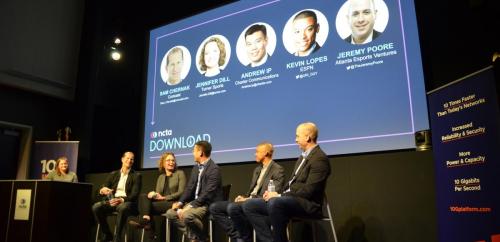"I would say, in its simplest definition, esports means competitive video games," said Kevin Lopes, director of business development at ESPN. At a recent panel held at NCTA, esports executives came together to talk about the fast-growing craze and what audiences have to look forward to. This rich and immersive form of entertainment is captivating not only hard core gamers, but casual viewers across the country as well. But it turns out that esports is more than meets the eye; Lopes and fellow panelists made sure to demonstrate the many facets that make up esports and the challenges the cable industry is working on to ensure future success.
It’s unfair to lump all the different games together in esports–each one caters to different demographics and different audiences, after all–and compare it to one single traditional sport. "When people look at esports, it’s important to look at the traditional genre or even drill down to the title," explained Lopes.
Jennifer Dill, Turner Sports Vice President of Esports, said that esports is also more complex in that it contains not just a competitive element but also a viewability component. "There are a lot of games that are great for someone to play, but not ideal for someone to view as a third party," said Dill. Turner is continually working on figuring out how to present games to fans sitting at home in a way that will make them understand the action going on.
From a storytelling perspective, Dill elaborated that one of the network's biggest challenges on this front is conveying the expertise and level of play that many of the players have in the sport. Take basketball, for example. Viewers can see the sweat on a player's face, and how hard someone is competing. But in esports, it's more difficult to show that layer on the screen and the elite level of technical moves that players are working on. "We are always thinking of ways to show that so that you get immersed into that experience the same way as you do in a traditional sport," added Dill.
There's no denying that the technical aspect of esports, both in the game and on the backend, is a whole new space that is still being tested and perfected. Lopes shared that esports production poses many challenges because it involves millions of dollars of technology that require a high quality and secure local area internet network, high level PCs, and an "effective observer mode," meaning an infinite number of camera placements within a virtual game. "You can put a camera anywhere if you have that technology built into the game. But if you don't, it requires manual labor," said Lopes.
Fortunately, the strength of broadband networks has improved exponentially over the past decade, and speeds will only get faster as the cable industry prepares to unleash the 10G era. In gaming, that means lower latency and a winning advantage. "Latency is everything to a gamer," said Jeremy Poore, director of partnerships for Atlanta Esports Ventures. For both professionals and amateurs, even a millisecond makes a huge difference, and could move someone to the next ranking, or get them discovered by the big leagues.
Another technical aspect being worked out in the esports space is the capability of venues to be able to host these types of events. Poore explained that most music venues he found in Atlanta didn't meet the qualifications that esports leagues require, but that is changing. Comcast is building a new esports stadium which will be home to the Philadelphia Fusion—a professional esports team in the Overwatch League. The arena is a 3,500 seat, leading edge facility equipped to handle over 120 esports events each year, and slated to open in 2021.
"I see what is happening at the Fusion Arena, and it's a bit of a glimpse into what's going to happen next in the home," said Andrew Ip, senior vice president of emerging technology & innovation at Charter Communications. “You can look at any cable network. There's already a lot of gaming that occurs over the networks today. This year though, the penetration of virtual reality hit about 50%. These things are happening in part because networks are pretty capable."
As Ip stated, the technology is getting there, thanks to the powerful broadband networks that advance every year. The storytelling aspect, however, has always been there, and will only continue to give esports momentum as mainstream audiences find themselves immersed and engaged in ways they never knew possible. "I get frustrated when I hear people say, why would anyone want to watch other people play video games?" said Lopes. "It's a communal opportunity to play with friends you don't get to see or talk to normally, over headsets once a week. That's a real social experience that brings people together, but there's this public perception that it does not. That public perception needs to change, and its incumbent on us to tell that story."
